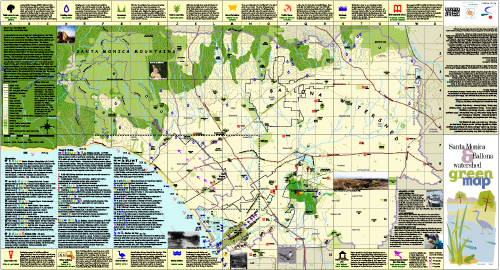Santa Monica, CA 2000
page 1

The Ballona Watershed Green Map displays ecological and cultural resources found throughout the Ballona Watershed. This includes important waterways, wildlife migration routes, wetlands, public lands, alternative transportation corridors, environmental organizations and green businesses.
WHAT IS A WATERSHED?
and why make a watershed map?
A watershed is an area of land that drains all of the rain that falls within it to a common point. This map identifies environmental features and resources in the Ballona Watershed, which is part of the larger Santa Monica Bay Watershed.
The Ballona Watershed drains through Ballona Creek to Santa Monica Bay. Studying a watershed gives us a unique look at the relationships between water, earth, and people. Watersheds provide habitat for plants and animals and provide important environmental benefits such as water filtration and storage. The hydrologic cycle (precipitation, percolation and evaporation) shapes the earth's topography which affects the plant and animal species found in the area.
page 2
Humans rely on watersheds by making use of water habitat. However, by channeling streams and paving over the earth, we have drastically altered the original percolation and filtration zones of the watershed. It is our hope that the reader will contemplate these changes, and also dream of how we might restore some of the watershed while continuing to enjoy living an urban life in Southern California.
The Ballona Watershed Green Map shows the entire watershed of La Ballona Creek including the communities of Santa Monica, Culver City, Beverly Hills, Inglewood, West Hollywood, Venice, West Los Angeles, and Los Angeles. It also shows the natural features that run throughout the watershed.
These features include:
- Watershed definition and boundaries.
- Existing, as well as former creeks and streams.
- Water sources inventory (the source of local water).
- Fresh water sources such as reservoirs and lakes.
- Storm water pollution sources (which affect water quality in the watershed and Santa Monica Bay)
- Bird migration corridors and species.
- Native plant, butterfly and animal information.
- Endangered species.
- State parks.
- Current greening and habitat restoration projects and opportunity sites.
- Environmental schools (schools that have agreed to unpave a large percentage of asphalt and plant trees).
For more information www.LAGreenMap.org and www.idarchitect.com.



